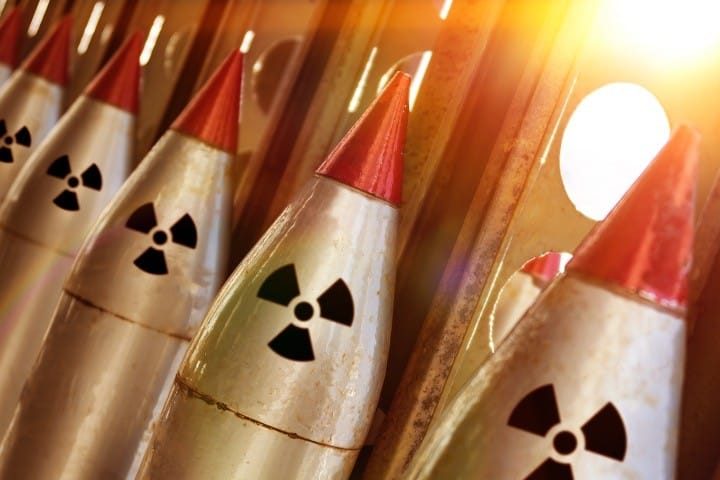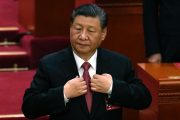
China’s nuclear arsenal is expected to more than triple, to 1,500 warheads, by 2035, the Pentagon declared in a Nov. 29 report that also pointed out how the country’s air force has become more advanced.
Washington has publicly named Beijing as the most significant challenge to the United States.
The yearly report on China’s military highlighted enhancements to both its nuclear and conventional forces.
“The Department of Defense estimates that [China’s] operational nuclear warheads stockpile has surpassed 400,” the report indicated, and “if China continues the pace of its nuclear expansion, it will likely field a stockpile of about 1,500 warheads” by 2035.
In context, the aforesaid figure would still trail far behind the stockpiles of the United States and Russia, which each contain several thousand nuclear warheads.
The report also claimed that China is stepping up efforts to upgrade its ballistic missiles that could deliver nuclear weapons. The communist country tested around 135 missiles in 2021 — “more than the rest of the world combined” — in addition to missiles fired in conflicts.
The report noted that Beijing’s air force is making progress and “rapidly catching up to Western air forces.”
Prior to the report’s release, a senior defense official said the Chinese air force is “trying to … progress rapidly on all fronts,” such as on the apparatus it operates as well as its pilots and other personnel.
Notably, the report pointed out China’s military actions in the Indo-Pacific region, saying that the Chinese military has “adopted more coercive and aggressive actions.”
For example, a visit by U.S. House Speaker Nancy Pelosi to Taiwan in August of this year ruffled Beijing’s feathers, prompting the communist regime to step up its pugilistic behavior, such as conducting its largest and most bellicose military exercises around Taiwan since the 1990s.
Although both the United States and China have since attempted to fan the flames of tension, this same senior defense official admitted that while Chinese military activity around Taiwan has quieted, it still has increased.
Beijing is “establishing kind of a new normal in terms of the level of military activity around Taiwan following the speaker’s visit,” the official said. “Even though we don’t see an imminent invasion, obviously, that sort of an elevated level of … intimidating and coercive activity around Taiwan” is a cause of worry.
In his inaugural face-to-face meeting with Defense Minister Wei Fenghe earlier in November, U.S. Secretary of Defense and Pentagon chief Lloyd Austin called for China to eschew “destabilizing actions” toward Taiwan.
On the fringes of the ASEAN Defense Ministers’ Meeting this month, Austin urged both sides to sustain open lines of communication and cautioned against “increasingly dangerous behavior” by Chinese military aircraft in the Indo-Pacific region, based on a statement and briefing by U.S. officials after the talks.
Chinese officials deemed the approximately 90-minute meeting positive, and concurred on the importance of enhancing crisis management. However, the Chinese placed the blame on the U.S. for worsening relations between the two world powers.
“The responsibility of the current state of affairs of China-US relations does not lie with China — the main reason is that the US has made the wrong strategic judgment,” Defense Ministry spokesman Tan Kefei told reporters in Cambodia. Tan said the United states should “adopt a rational and practical China policy so as to really remove the root causes of crisis.”
The meeting between Austin and Wei was one in a series of attempts to stabilize the U.S.-China relationship after the first in-person talks between Chinese President Xi Jinping and U.S. President Joe Biden in Indonesia.
While both countries have unresolved, entrenched differences over a variety of matters — such as Taiwan, human rights, U.S. restrictions on tech exports, and other issues — the two sides sought to resurrect the fundamentals to prevent disputes from getting out of hand.
Earlier in November, Biden administration officials publicly admitted for the first time that China has launched new, longer-range ballistic missiles on its six nuclear-powered submarines, enabling it to target the continental United States from much nearer to its territory.
Adding fuel to the fire, Beijing also persists in claiming a huge portion of the South China Sea, pitting it against other nations such as Vietnam and the Philippines.
Consequently, the U.S. has increased attempts to “shape the strategic environment around Beijing” to advance American interests in response to perceived Chinese inroads in the Indo-Pacific region.
Alluding to U.S. activities in the region, Xi said, “The Asia-Pacific is no one’s backyard and should not become an arena for a big power contest.”
Ahead of the meeting with Austin on Tuesday, Wei also lampooned American efforts to sell arms to Taiwan.
China regards the self-governing democracy of Taiwan as a breakaway province awaiting reunification with the communist mainland, by force if need be. In contrast, Taiwan dismisses China’s sovereignty claims.
After Pelosi’s visit to Taipei, China canceled a call scheduled between military officials, according to a U.S. official. When questioned if the series of recent talks implied a thaw in bilateral tensions, the same official remarked that “competition” remains the hallmark of U.S.-China relations.
Both major powers also discussed the crisis in Ukraine and stressed that they “oppose the use of nuclear weapons or threats to use them.”
Austin also lambasted recent North Korean missile launches, and urged China to “fully enforce” the United Nations Security Council resolutions against Pyongyang’s weapons program.
The Chinese readout omitted the mention of nuclear weapons, but did say that both sides exchanged stances on the South China Sea, Ukraine, and the Korean peninsula.



